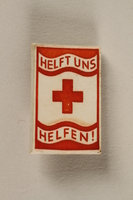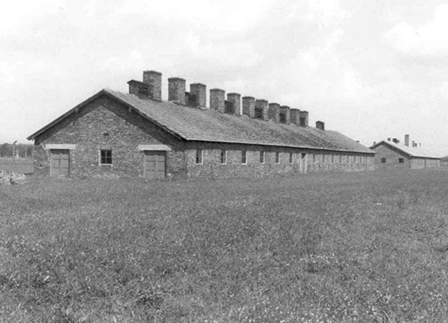Overview
- Brief Narrative
- Pin issued by the Winterhilfswerk Des Deutschen Volkes [Winter Relief Agency of the German People], a public charity fundraising organization established in Germany by the Nazi Party in 1933. In addition to fundraising, the organization was used by the Nazi regime to promote Volksgemeinschaft, a sense of community, among the German people.
- Date
-
issue:
1933-1934
- Geography
-
manufacture:
Germany
- Credit Line
- United States Holocaust Memorial Museum Collection, Gift of the University of Mary Washington Galleries
- Markings
- front, center, yellow paint : VDA
front, top border, blue enamel paint : Volksgenosse hilf! [Comrade, help!]
front, bordering sides and bottom, blue enamel paint : Winterhilfswerk Des Deutschen Volkes 1933-1934 [Winter Relief Agency of the German People, 1933-1934] - Contributor
-
Distributor:
Winterhilfswerk Des Deutschen Volkes
Physical Details
- Language
- German
- Classification
-
Identifying Artifacts
- Category
-
Badges
- Object Type
-
Lapel pins (aat)
- Physical Description
- U-shaped, metal pin with a center design in blue paint on a yellow background. It depicts a blue pennant with 3 yellow letters on a pole. Around the edge is German text in black, enclosed in a blue painted border. A pin clasp is attached at top. The back is blank.
- Dimensions
- overall: Height: 1.250 inches (3.175 cm) | Width: 1.000 inches (2.54 cm) | Depth: 0.125 inches (0.318 cm)
- Materials
- overall : metal, paint
Rights & Restrictions
- Conditions on Access
- No restrictions on access
- Conditions on Use
- No restrictions on use
Keywords & Subjects
Administrative Notes
- Legal Status
- Permanent Collection
- Provenance
- The Nazi charity lapel piin was donated to the United States Holocaust Memorial Museum in 2005 by the University of Mary Washington Galleries.
- Record last modified:
- 2023-08-31 10:41:50
- This page:
- http://collections.ushmm.org/search/catalog/irn517383
Download & Licensing
In-Person Research
- By Appointment
- Request 21 Days in Advance of Visit
- Plan a Research Visit
- Request to See This Object
Contact Us
Also in University of Mary Washington Galleries collection
The collection consists of artifacts relating to the Nazi regime in Germany from 1933 to 1945.
Date: 1933-1945
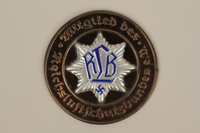
Reichsluftschutzbund house marker
Object
Plaque identifying membership in the Reichsluftschutzbund [National Air Protection League], a civil defense corps in Germany under the Nazi regime. The plaque would have been mounted on the door to identify the home of a member. The membership consisted of civilians trained to assist the public in the event of an air raid.

Pin from a Nazi Party local council meeting
Object
Commemorative pin from a local meeting of a Nazi Party in the German city of Gera in 1936. The design features the Reichsadler, an eagle holding a wreath with a swastika in the center. The national emblem of Nazi Germany, it was added to many display items throughout the country.
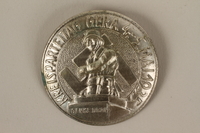
Pin from Nazi Party district meeting
Object
Commemorative pin from a local meeting of a Nazi Party in the German city of Gera in 1936. The design features the Reichsadler, an eagle holding a wreath with a swastika in the center. The national emblem of Nazi Germany, it was added to many display items throughout the country.
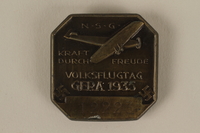
Pin from Kraft durch Freude aviation event
Object
Commemorative pin issued for the People's Day of Flight, an aviation event held by the Kraft durch Freude [Strength Through Happiness] movement in the German city of Gera in 1933. Kraft durch Freude was a state-sponsored national organization under the Nazi regime that promoted organized leisure activities for the German workforce.
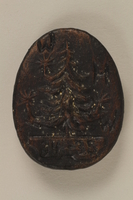
Winterhilfswerk Des Deutschen Volkes lapel pin
Object
Pin issued by the Winterhilfswerk Des Deutschen Volkes [Winter Relief Agency of the German People], a public charity fundraising organization established in Germany by the Nazi Party in 1933. In addition to fundraising, the organization was used by the Nazi regime to promote Volksgemeinschaft, a sense of community among the German people.
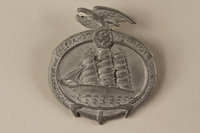
Pin commemorating Tag der Deutschen Seefahrt
Object
Pin commemorating Tag der Deutschen Seefahrt [Day of German Seafaring], a nautical event in 1935. The design features the Reichsadler, an eagle holding a wreath with a swastika in the center. The national emblem of Nazi Germany, it was added to many display items throughout the country.

Pin commemorating 700th anniversary of the city of Gera, Germany
Object
Pin commemorating the 700th anniversary in 1937 of the city of Gera, in the German state of Thuringen. The symbol of a shield with a lion holding up a swastika was created for Thuringen by the Nazi regime.
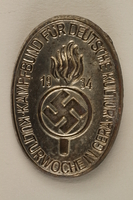
Kampfbund fur Deutsche Kultur pin
Object
Commemorative pin from an event held in Gera, Germany, by the Kampfbund fur Deutsche Kultur [Fighting League for German Culture], a cultural watchdog organization operated by the Nazi Party from 1928 to 1934. The organization opposed the involvement of Jewish writers, composers, and artists in German culture, and opposed other figures who did not fit the organization's concept of German culture under Nazism. The organization held book-burnings and other events.
![Auslandsdeutschen [Association of Germans of Foreign Lands] pin Auslandsdeutschen [Association of Germans of Foreign Lands] pin](https://www.ushmm.org/media/emu/get?irn=517391&mm_irn=16633&file=secondary)
Auslandsdeutschen [Association of Germans of Foreign Lands] pin
Object
Commemorative pin from an international convention of the Auslandsdeutschen in the German city of Stuttgart in 1937. The Auslandsdeutschen was the organization of members of the Nazi Party who lived abroad.
![Reichsparteitag [Nazi Party] national convention pin Reichsparteitag [Nazi Party] national convention pin](https://www.ushmm.org/media/emu/get?irn=517392&mm_irn=16632&file=secondary)
Reichsparteitag [Nazi Party] national convention pin
Object
Pin commemorating the 1937 Reichsparteitag, the annual national convention of the Nazi Party, held in Nuremburg, September 6-13, 1937.
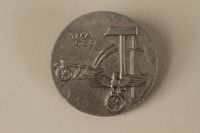
Nazi Party pin for Labor Day 1936
Object
Nazi Party Labor Day (Tag der Arbeit) 1936 pin. Labor Day (also known as May Day) takes place on May 1 to celebrate laborers and the working classes. In April 1933, after the Nazi party took control of the German government, May 1 was appropriated as the “Day of National Work,” with all celebrations organized by the government. On May 2, the Nazi party banned all independent trade-unions, bringing them under state control of the German Labor Front. This style of mass-produced, die-struck metal pin is often referred to colloquially as a tinnie.
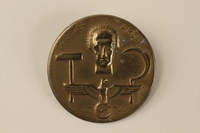
Nazi Party pin for Labor Day 1934
Object
Nazi Party Labor Day (Tag der Arbeit) 1934 pin. Labor Day (also known as May Day) takes place on May 1 to celebrate laborers and the working classes. In April 1933, after the Nazi party took control of the German government, May 1 was appropriated as the “Day of National Work,” with all celebrations organized by the government. On May 2, the Nazi party banned all independent trade-unions, bringing them under state control of the German Labor Front. This style of mass-produced, die stamped pin is often referred to colloquially as a tinnie.
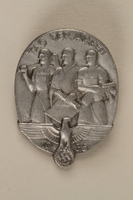
Nazi Party pin for Labor Day 1935
Object
Nazi Party Labor Day (Tag der Arbeit) 1935 pin. Labor Day (also known as May Day) takes place on May 1 to celebrate laborers and the working classes. In April 1933, after the Nazi party took control of the German government, May 1 was appropriated as the “Day of National Work,” with all celebrations organized by the government. On May 2, the Nazi party banned all independent trade-unions, bringing them under state control of the German Labor Front. This style of mass-produced, die-struck metal pin is often referred to colloquially as a tinnie.
![Tag des Deutschen Volkstums [Day of German Nationality] pin Tag des Deutschen Volkstums [Day of German Nationality] pin](https://www.ushmm.org/media/emu/get?irn=517396&mm_irn=16637&file=secondary)
Tag des Deutschen Volkstums [Day of German Nationality] pin
Object
Pin commemorating Tag des Deutschen Volkstums in 1934 in Gera, Germany. Established by the Nazi Party, the day was observed in schools and elsewhere to promote cultural identity among the German people.

Miniature figurine in Bavarian dress with a fish for charity campaign donors
Object
Small painted ceramic figurine given as a memento to donors in appreciation for their contribution to the Winterhilfswerk Des Deutchen Volkes (Winter Charity Campaign]. This figurine is from the March 1939 series, Schaffendes Deutchsland [Productive Germany]. It was originally a pin. The WHW was a public charity fundraising organization established in Germany by the Nazi Party in 1933. In addition to fundraising, the organization was used by the Nazi regime to promote Volksgemeinschaft, a sense of community, among the German people.
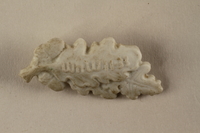
Winterhilfswerk Des Deutschen Volkes pin
Object
Pin of the Winterhilfswerk Des Deutschen Volkes, a public charity fundraising organization established in Germany by the Nazi Party in 1933. In addition to fundraising, the organization was used by the Nazi regime to promote Volksgemeinshaft, a sense of of community among the German people.

Winter Relief Agency of the German People donation badge
Object
Pin of the Winterhilfswerk Des Deutschen Volkes [Winter Relief Agency of the German People], a public charity fundraising organization established in Germany by the Nazi Party in 1933. In addition to fundraising, the organization was used by the Nazi regime to promote Volksgemeinschaft, a sense of community among the German people.
![Fest der Jugend [Festival of Youth] pin Fest der Jugend [Festival of Youth] pin](https://www.ushmm.org/media/emu/get?irn=517401&mm_irn=16625&file=secondary)
Fest der Jugend [Festival of Youth] pin
Object
German pin commemorating a youth festival held by the Hitler Youth in 1933.
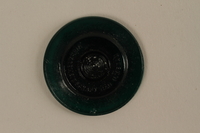
Mother's Day medallion issued by NS-Frauenschaft, Nazi Party
Object
German glass medallion commemorating Mother's Day in 1935, issued by the NS-Frauenshaft, the National Socialist Women's League, the women's auxiliary of the Nazi Party.
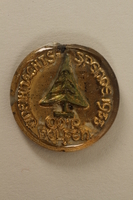
Christmas pin with evergreen issued for the Nazi winter charity drive
Object
Pin issued for a 1933 Christmas charity drive in Germany. It was probably issued by the Winterhilfswerk Des Deutschen Volkes, the major public charity established by the Nazi Party in 1933. In addition to fundraising, the organization was used by the Nazi regime to promote Volksgemeinshaft, a sense of of community among the German people. They often issued pins and badges for donors to wear to show their support.
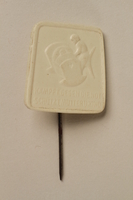
White plastic pin with a mother and baby for a Nazi Party charity drive
Object
Plastic stickpin from a WHW charitable campaign to raise funds for women and children in need. The Winterhilfswerk (WHW / Winter Relief) was the major charity organization of the Nazi Party in Germany. Pins or badges such as this were offered to people who donated to the fund.
![Nazi Party Freiheit und Brot [Freedom and bread] campaign pin Nazi Party Freiheit und Brot [Freedom and bread] campaign pin](https://www.ushmm.org/media/emu/get?irn=517407&mm_irn=16619&file=secondary)
Nazi Party Freiheit und Brot [Freedom and bread] campaign pin
Object
Political campaign pin from the Reichstag election in Germany on March 29, 1936. The Nazi Party was the only party on the ballot. The pin features the slogan "Freedom and bread," which the Nazi Party had used during its rise to power.

Volksbund fur das Deutschtum im Ausland pin
Object
Pin from the Volksbund für das Deutschtum im Ausland, the National Association for Germans Abroad.

Nazi Party Congress badge from a rally in Weimar
Object
Commemorative pin from a Nazi Party rally in Weimar, Germany, in July 1936. The rally marked the tenth anniversary of a Nazi Party Congress in Weimar in 1926. Before the Nazi Party came to national power in 1933, it held annual congresses such as the one in Weimar. This style of mass-produced, die-struck metal pin is often referred to colloquially as a tinnie.

Pin of the letters JA for a Nazi Party campaign
Object
Nazi Party campaign pin from the German Reichstag elections of November 12, 1933. "Ja" was a slogan for the Nazi Party, the only party allowed to run. A simple "yes" was sufficient for voters to approve the Party's slate of candidates.
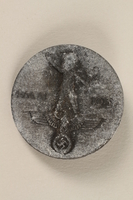
German Labor Day pin
Object
Pin issued in Germany in 1937 to commemorate Labor Day. The national holiday was established by the Nazi government in 1933 and observed on May 1.

NSDAP pin from a local Nazi Party meeting
Object
Commemorative pin from a local meeting of the Nazi Party in the German district of Thüringen. The design features the Reichsadler, an eagle holding a wreath with a swastika in the center. The national emblem of Nazi Germany, it was added to many display items throughout the country.
![Flugtag [Flight Day] pin Flugtag [Flight Day] pin](https://www.ushmm.org/media/emu/get?irn=517413&mm_irn=16609&file=secondary)
Flugtag [Flight Day] pin
Object
Commemorative pin for an aviation event held by the Nazi Party in the German city of Gera.

Winterhilfswerk Des Deutschen Volkes pin
Object
Pin of the Winterhilfswerk Des Deutschen Volkes [Winter Relief Agency of the German People], a public charity fundraising organization established in Germany by the Nazi Party in 1933. In addition to fundraising, the organization was used by the Nazi regime to promote Volksgemeinschaft, a sense of community among the Germany people.

King Frederick II commemorative pin
Object
Pin from 1936 commemorating the 150th anniversary of the death in 1786 of King Frederick II of Prussia, also known as Frederick the Great.
![Deutsche Arbeitsfront [German Labor Front] pin Deutsche Arbeitsfront [German Labor Front] pin](https://www.ushmm.org/media/emu/get?irn=517416&mm_irn=16612&file=secondary)
Deutsche Arbeitsfront [German Labor Front] pin
Object
Pin commemorating a 1934 march in the German city of Gera by the Deutsche Arbeitsfrong [German Labor Front.] The national labor union was established by the Nazi Party in 1933.

Pin from a VDA charity drive
Object
German pin with acronym VDA, for a charitable fundraising campaign, possibly as part of the events promoted for German Nationality Day. This was an event established by the Nazi Party to promote cultural identity among the German people.
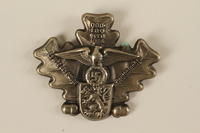
Oak cluster lapel pin with Reichsadler for a Nazi Party meeting
Object
Commemorative pin from a 1934 local meeting of the Nazi Party in the German city of Gera, in the district of Thüringen. The design features the Parteiadler (Party’s Eagle) and a shield, with a striped lion holding up a swastika. The Parteiadler, an eagle looking over its left shoulder and holding a wreath with a swastika in its talons, is similar to the Hoheitsabzeichen (National Emblem) of Nazi Germany, which features the eagle looking over its right shoulder. Both of these are variations of the Reichsadler (Imperial Eagle), which has been used as a symbol for German nationhood as far back as the Holy Roman Empire, although the term is often associated with the Nazi regime. The lion shield is drawn from the 13th-century coat of arms for Thürgingen, which was redesigned with the swastika after the Nazi party took control of Germany in 1933. The emblem and coat of arms are overlaid on a trio of oak leaves, an important symbol in Nazi iconography for the connection between German people and the land.
Pin for Nazi Party district meeting
Object
Pin issued for a district meeting of the Nazi Party in Erfurt, Germany, on June 4, 1933



